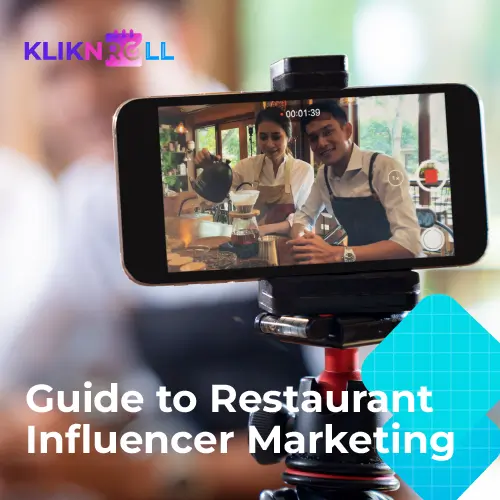Table of Contents
Restaurant influencer marketing is nothing new and you might’ve seen them popping around once in a while. But are you looking to try to see if they’re worth the money?
Don’t worry, in this article, we’ll go through everything you need to know about influencer marketing for restaurants!
What Exactly is a Food Influencer?
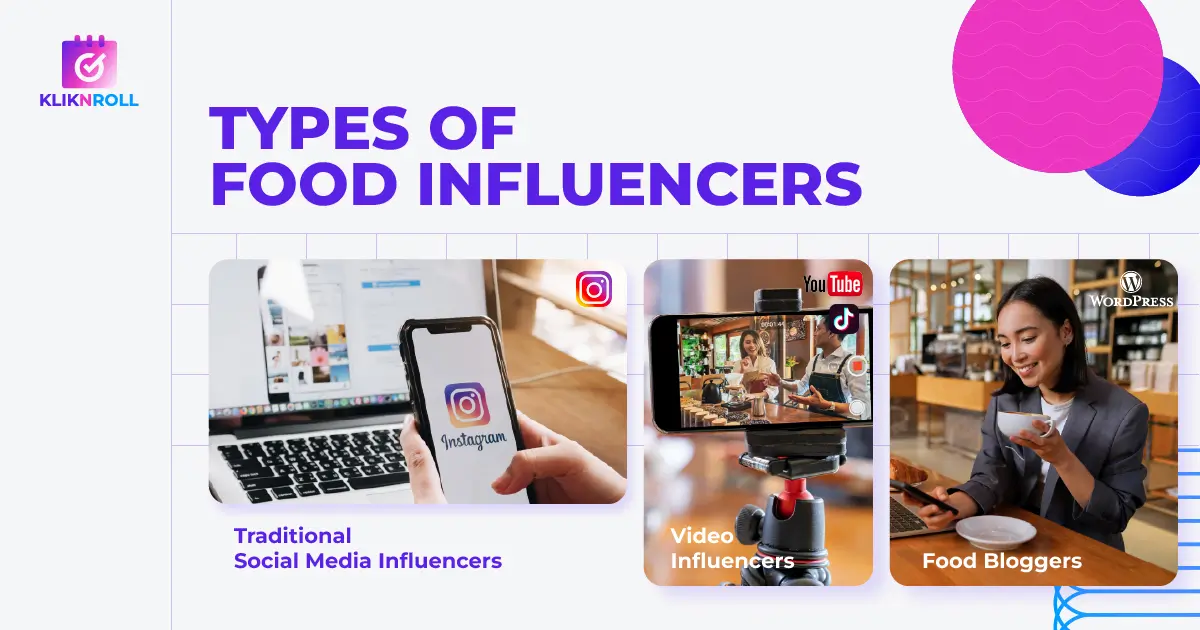
Food influencers typically come in 2 forms: food bloggers who write about food on their blogs or websites, and key opinion leaders who share food content on social media platforms such as Instagram, TikTok, Facebook, and YouTube.
The difference between them is the stage of the funnel that their audience is in.
Influencers on social media platforms can reach people who are not necessarily looking for places to eat or who are not in your area. You have no control over who sees their content.
Food bloggers, however, target people who are actively searching for places to eat in a specific area. They optimize their blogs or websites for search engines.
This means that people who visit their sites are more likely to be interested in visiting your restaurant.
Social media influencers can boost your brand and awareness, but they may not bring as many customers.
However, the content and the influencer also matter – you can get more customers if they focus on just one city or maybe organize clips into a series where it’s easy for people to find.
TikTok and YouTube have search features too, but people usually don’t use them to look for food (at least not yet). Their algorithm decides what content and videos to push to potential customers.
On the other hand, working with a food blogger can improve your conversion rate because people are already finding restaurants to eat, and they can easily find directions or order online if you optimize it properly.
How Much Should Restaurants Pay for Food Influencer Marketing?
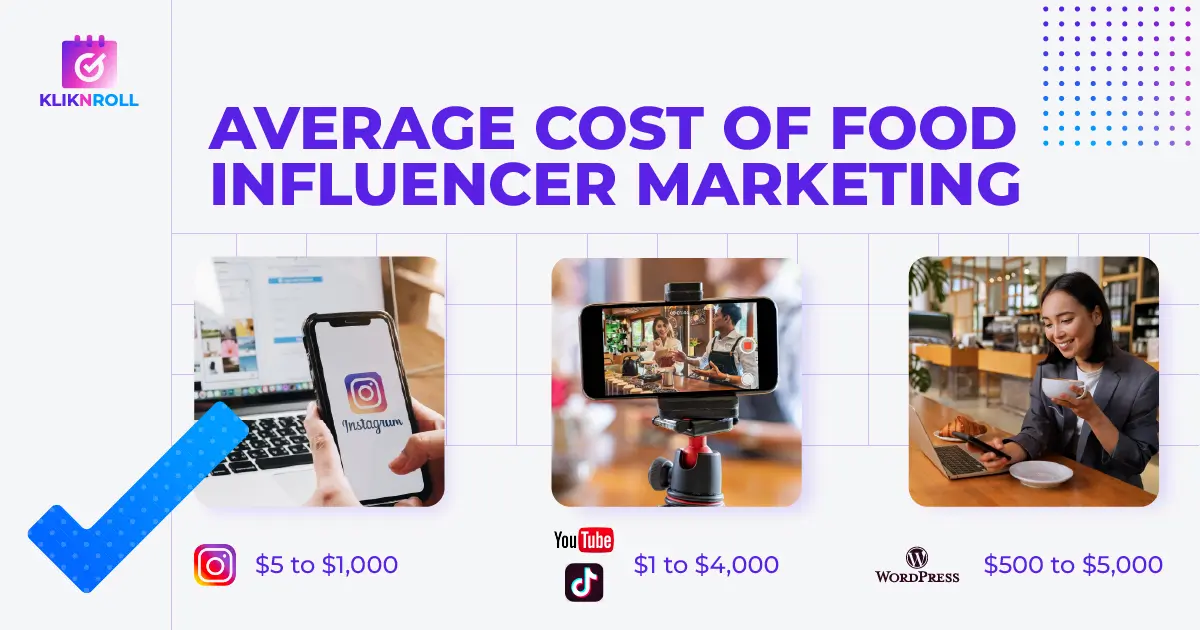
Depending on their location and following, you can expect to pay around $5 to $1000 for an Instagram post or story, $1 to $4,000 for a TikTok video, and $500 to $5,000 a month to be on the list of big food blogs.
Instagram stories only last a day, and we think the ROI is not worth it since it’s only 24 hours. An Instagram post will last longer since it stays on their profiles (unless they delete it).
TikTok videos last longer too, as some TikTok videos are still shown to viewers after a year. This is a good mix of cost, time, and conversion – as many people search on TikTok and YouTube for food ideas.
Being on a blog post is the best value, because of its focused intent (people search on Google when they want to eat something). This is a good way to get regular customers because good blog posts are still seen even after 10 years sometimes!
The price for being in the blog post also varies depending on the spot. Being the number 1 spot will yield more clicks and conversions compared to anything below.
Benefits of Hiring a Restaurant Influencer
Hiring food influencers can bring quite a lot of benefits like:
Less Internal Resources Spent on Marketing
Influencers can help you reduce the time and investment needed to build a website, or a social media presence online.
All of these can be resource-intensive, like creating posts, growing a website’s traffic, and generating leads. Essentially, get someone else to think of great and creative ways to market your restaurant.
Trust and Authority
The term “Key-Opinion Leaders” (KOL) reflects the power of influencers in their niche (where key opinion consumers are).
These consumers tend to believe and follow what these KOLs say, which can boost your visits and referrals.
Branding & Awareness
Branding and awareness are good because your restaurant will come to mind when people talk about a certain place.
For instance, when people think of New York they may think of well-known places like Katz Deli – which is very popular.
But you may have to spend more before getting this benefit because customers usually need 5-7 impressions to recall your brand!
How Do You Find the Right Food Influencers to Promote Your Restaurant
Food Bloggers
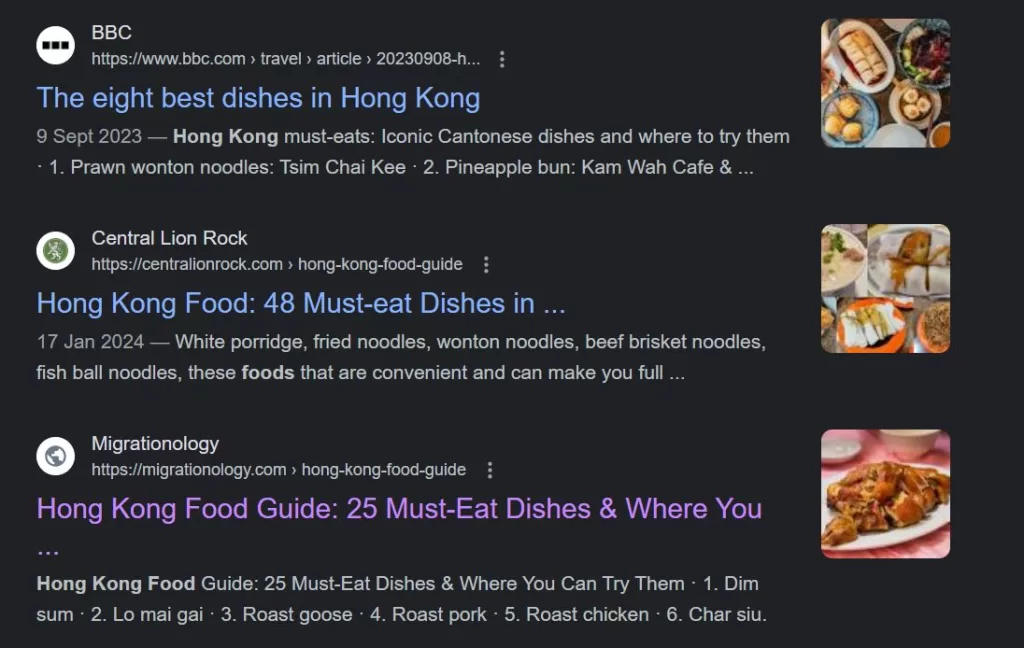
Finding food bloggers to promote your restaurant is very straightforward. Here’s a step-by-step guide to find them:
- Go on Google.
- Type in the keywords “Restaurant + [your city]” and “[Your Cuisine] Restaurant + Your City]”. You can adjust the specificity by using a smaller area or a larger region instead of your city – like a district or state. So for example, instead of “Japanese Restaurant in Hong Kong”, you can change it to “Japanese Restaurant in Kwun Tong” (a district within Hong Kong), to be more specific.
- Depending on location, you might find big magazines or review sites like TripAdvisor.
- Ideally, look for independent bloggers because they’ll rank around the same position as the big magazines but are willing to work with you for a fraction of the cost.
- You can then curate a list of 5 to 10, or however many you choose.
- You can also do more and use Ahref’s free website traffic checker tool to see which websites are good or not. The more traffic they have, the more you pay (but you only want to be in the blog post about your area – use that to negotiate).
Social Media Influencers
Social media influencers can be trickier in hindsight, because of the global nature of these social media platforms. Not to mention the fact that these platforms push content to people who might not be looking for something to eat right now – so the search intent is simply not there.
However, the first thing you can do is to search for “food in [your city] on TikTok and YouTube and see who pops up. Usually, micro-influencers will be there, as they’ll niche down to cities, instead of countries or states, which are typically monopolized by big players.
Once you’re in their profile, look for trends in the places they visit. So, if they post videos of different food spots in your city, chances are that they’re based there and you’ll be able to get them to check you out.
It’s a good approach because the younger generation like Gen Zs are increasingly looking to platforms like TikTok to search for things.
Guide to Get Started With Restaurant Influencer Marketing
Reach Out to the Influencers Through Email/Contact Form/Direct Message
Before reaching out to them, make sure you present yourself as a real brand and company. These influencers might get up to hundreds of messages per day and it’s important to build a level of trust before you go about reaching out.
If you decide to reach out to food bloggers, the single best thing you can do is to have a real business email. It should be something like “[email protected]”.
This establishes a level of trust and you’ll be more likely to get a reply. And if you haven’t done so, make sure that your Google Business Profile is up to date. Your restaurant’s profile has to pop up when they decide to do a Google search on your restaurant.
For social media influencers, it will help if you already have a decent following on social media. They will click on your profile if you send them a message and the more trust that you have the better.
The odds that they’ll bother giving you a reply will be low if you don’t have a profile picture and no posts. Try to get a properly done logo as your profile picture, having some photos or videos on your feed would help a lot.
Make sure your website, address, and phone number are displayed prominently on your social media profile – as this is quite a big deal for trust.
Ask for Data and Past Collaboration Results
Numbers matter in influencer marketing, and it’s not just about how many followers they have.
Ask about things like how engaged their audience is and who those people are. Here’s a quick list of important data:
- Demographics
- Engagement Metrics
- Monthly Traffic
Also, check out the results from their past collaborations. Knowing the impact an influencer has had on others helps you see if they can do the same for your restaurant. Look out for things like:
- Conversion Rate
- Clicks
- Campaign Duration
- Revenue (if possible)
Determine Your Payment Structure and KPIs
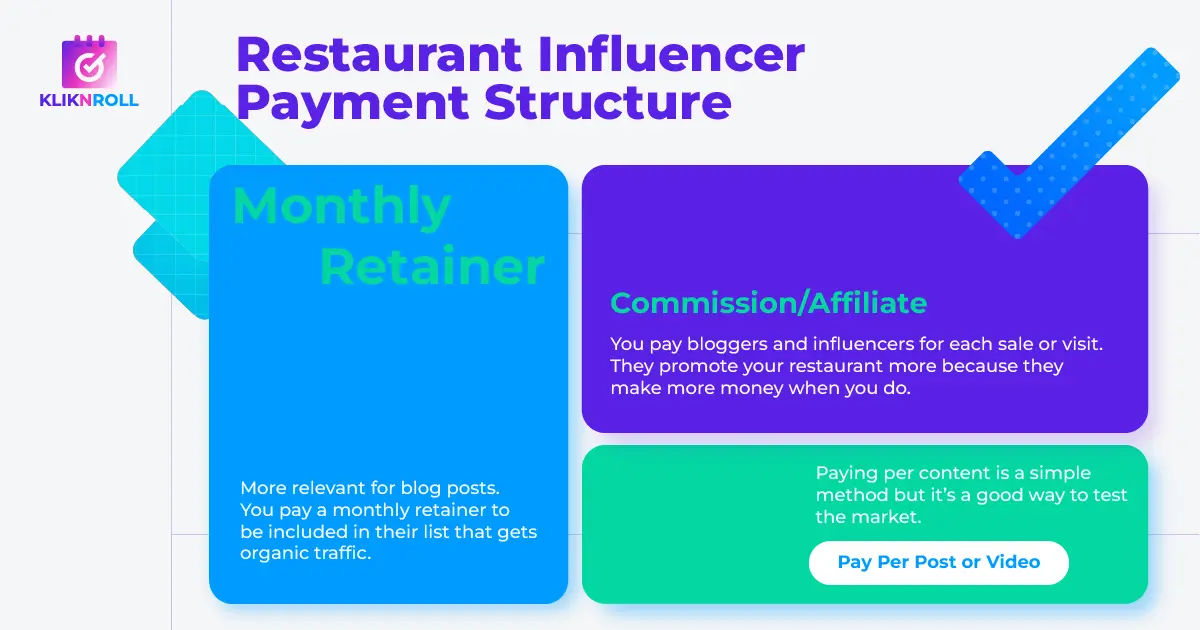
In terms of pricing, usually, most influencers will already have a pricing chart available, as mentioned earlier. Despite this, micro-influencers (who have a smaller but more engaged following) might be more open to negotiation.
There are 2 main ways that you can determine your payment structure which is:
- Pay Per Video/Post: Paying per piece of content is a relatively straightforward approach, as it’s more relevant for social media influencers. This is where they’ll go into your restaurant, try out your food, and film the process or take photographs for their posts.
- Commission/Affiliate: Affiliate commissions benefit both food bloggers and influencers. The concept is simple: you pay for each click on a link or for each successful conversion, like an order through your online platform or someone finding your restaurant through GPS. The advantage of this payment method is that you only pay when an actual conversion occurs. This means influencers are motivated to promote your restaurant more actively, as their earnings depend on the number of successful conversions you achieve!
- Monthly Retainers: One way to work with food bloggers is to pay them a monthly fee. These bloggers usually rank high for keywords that show people looking for food to eat, like “Japanese food in Hong Kong”, or “Corporate lunch in Singapore”. These keywords can bring you more customers. You want to be on their list of articles, and a monthly fee ensures that. The list has different spots with different prices and conversion rates. The top spot gets the most customers but costs the most. This can help restaurants that serve groups like offices or families, as you can get many group customers for a set price. The price is largely dependent on the average position of the post in the search engine results page, as well as the amount of local traffic it gets per month.
No matter which one you choose, definitely ironclad the agreement with a legally enforceable contract. Usually the influencer’s manager with draft one, so make sure that you read it (preferably with a lawyer present).
Decide What Type of Content to Choose
After deciding your structure, you can pick the type of content. Short videos are good because they reach more people.
You can also try a wider strategy like having influencers create a long YouTube video and then make it into several short videos to post on multiple platforms like YouTube shorts, TikTok, as well as Instagram Reels.
Many food bloggers also have YouTube channels with their blogs. You can get them to write a blog post about your restaurant and include you on their list articles.
They can also add a YouTube video to the blog post to get more searchers and keep them longer!
We suggest long videos, a blog review of your restaurant, being on their list of articles, and also having the long videos as shorts on TikTok – if you can.
This way, you get more exposure and trust from the local people and Google (if they link to your website from all content types). This strategy helps you build authority on your website and rank higher on the search page!
Evaluate Performance and Optimize
After running your campaign, you should gather data and evaluate performance. The key metrics to look out for are:
- Cost Per Lead: Cost per lead is how much you pay for a new customer. A good cost per lead for restaurants is $27 (but it varies by area). To find this, divide your total campaign cost by the number of leads you get. It’s hard to know how many leads you get for a restaurant, so you can use restaurant delivery data or the number of people who click your link (it could be your website or your Google Business Profile).
- Website Traffic: If you have a website, you can check your Google Analytics and see the traffic increase after the campaign goes live (on blog or social media). People who like a restaurant on TikTok may look for it on Google. You can use Google Search Console to see if you get more impressions and see if more people search for your brand on Google.
- Clickthrough Rate: Clickthrough rate shows how good the influencer’s content is. Good content gets more clicks – simple as that. You can find this by dividing the clicks (you can use tools like bit.ly) by the views. A good rate is about 2%. If you use the affiliate program, they will work hard to improve this!
- Overall Revenue and Sales Post Campaign: Usually, good content will generate hype in the first few days after launch, so expect more visits and revenue the days after campaigns go live.
- Sales of Mentioned Items: Influencers will typically talk about a couple of items, as opposed to the whole menu. You can gauge how effective the campaigns are simply by the percentage increase in orders of those items. If you’re seeing double the amount of orders for certain menu items, it’s a really good sign.
Examples of Great Food Influencers to Look Out For
For this part, we’re going to talk about macro-influencers, which are on the bigger end. For a cost-effective strategy, we suggest micro-influencers, who usually have less than 100,000 followers.
For the best strategy, balance price and reach, and look for trends and patterns among the influencers mentioned below and use them to find micro-influencers!
Short-Form & Long-Form YouTube Video Influencers
Strictly Dumpling / Mike Chen

Strictly Dumpling or Mike Chen (almost 6 million subscribers as of the writing of this article) is one of the first and most trusted food influencers on YouTube.
He’s humble and truthful with his reviews, and that’s why he has a huge and loyal fan base. Also, many of his videos get posted to local Facebook groups by his viewers (so more focused reach for you).
He also travels to different countries often, so you can surely get a spot if you’re from another country!
Best Ever Food Review Show
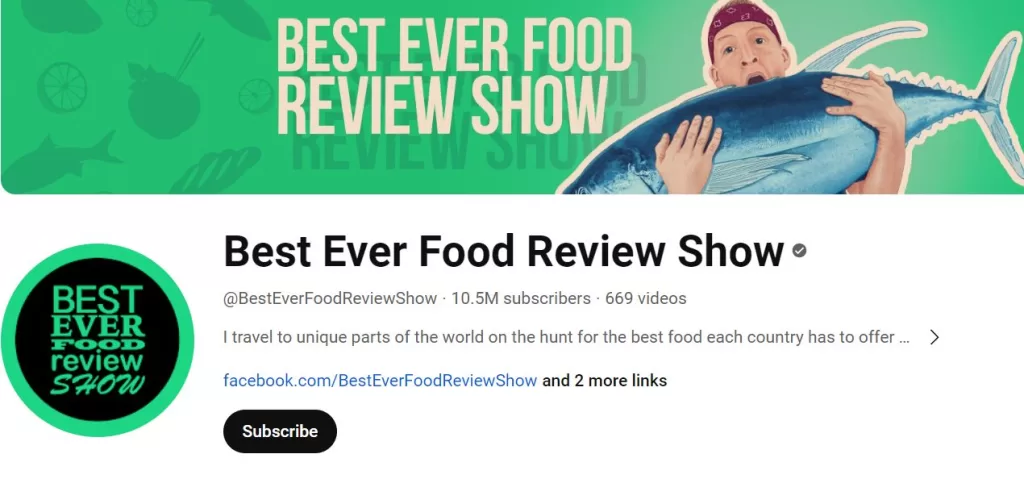
Sonny Side, or the Best Ever Food Review Show, is also a top food influencer with a global reach.
He visits many countries to try different foods and has a high engagement rate on most of his videos! He has a huge Instagram following too (almost 500k followers when this article was written).
He also describes all the food he ate in every video, which can help in conversion!
KarissaEats

Karissa is new to the food influencer scene but has already got up to 2.5 million subscribers on YouTube (when this was written).
She is good at short-form videos, which can get up to 5 million views. People enjoy her content because of her voice and fun personality, and that helps the algorithm show her videos to new viewers.
She also has over 3 million followers on TikTok, with over 200 million likes when this article was written! So if you’re a trendy cafe – you can reach Gen Zs and millennials (who are getting more spending power!) effortlessly through Karissa.
Food Bloggers
Will Fly for Food
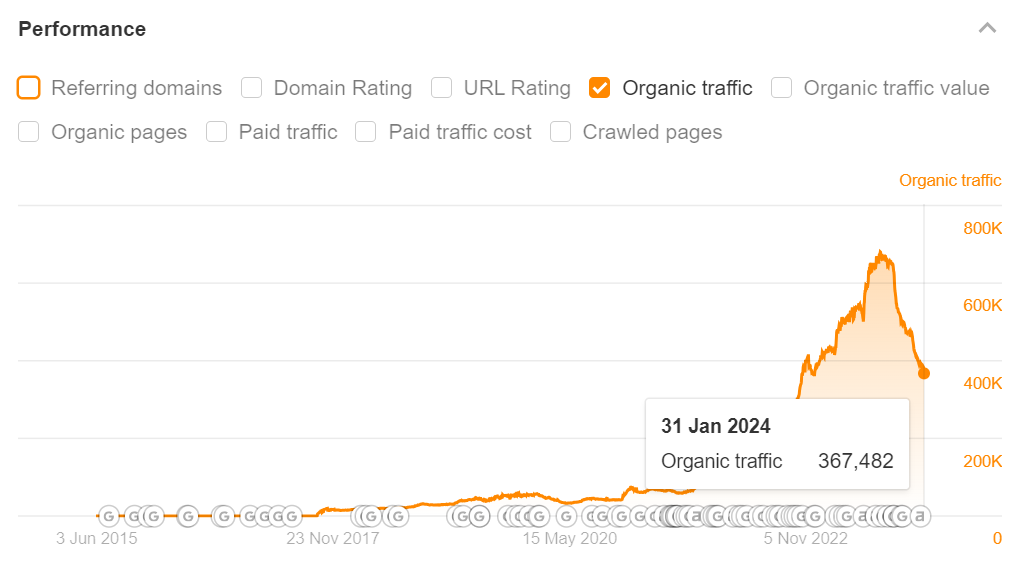
Will Fly for Food is a big food blogger with over 380,000 views per month from Google and they are one of the Top 50 Travel Blogs globally.
They write about different places and foods – which are easy to find on their website menu. Also, they are often on the first page on Google for keywords like “Food in [City]”, which has a high conversion rate.
They have a strong domain rating (website quality) of 57, which is good for independent bloggers. This means that other blogs can’t beat them easily!
Migrationology
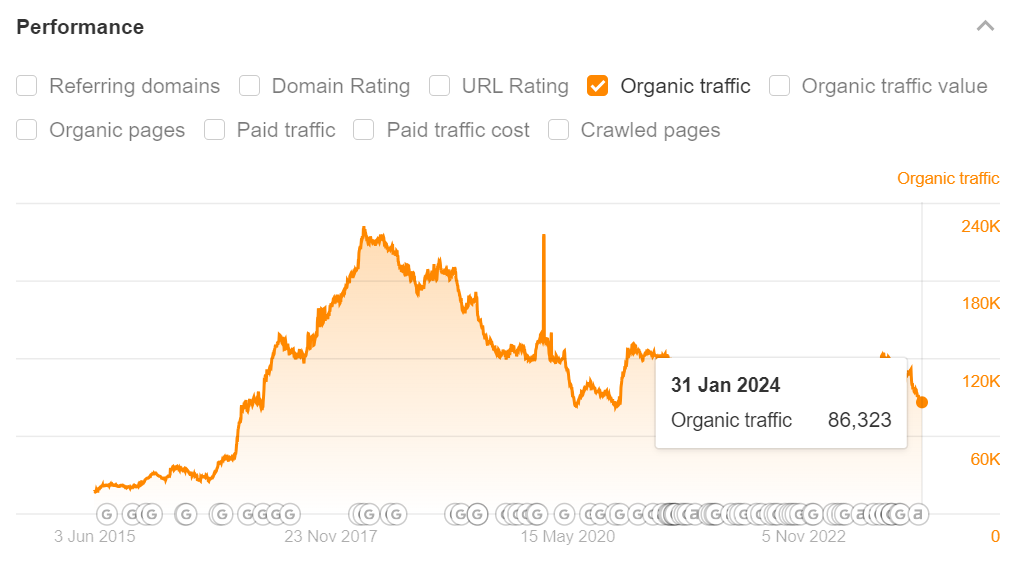
Migrationology is one of the oldest bloggers around. You might know him better as “Mark Weins”, which has over 10 million subscribers.
He is a prime example of a food blogger who also runs a successful YouTube channel. His blog is nothing to scoff at as well, as he gets over 100,000 highly-targeted organic visitors monthly.
If you find bloggers like Mark, you’ll be able to cover as much ground as possible, as he’s a big player in many platforms.
Conclusion
There you have it, a full guide on working with influencers of all types! If this article was helpful at all, feel free to take a look at some of our other articles like our guide on Restaurant SEO or Ways to Improve Your Restaurant’s Delivery Service!

Hey there! I’m Jeffrey Hau, and my journey in the digital world started after I wrapped up my psychology degree at UCLA. Imagine coming back to the bustling streets of Hong Kong from the tech haven of Silicon Valley – it was a whirlwind of inspiration! Seeing how social media platforms were evolving at breakneck speed and realizing the limitations of traditional advertising in this digital age, I decided to dive in.
In 2012, I laid the foundation of Prizm Group. From our humble beginnings, we’ve now blossomed into a global powerhouse with a team of over 200 passionate professionals. Our HQ is right here in Hong Kong, and we’ve spread our wings to SG, AU, NZ, JP, and China.
As a digital problem solver, our team found that several industries are in need of reservation systems, especially for F&B, Hotels, Beauty, and Medical sectors. Our digital magicians started crafting reservation systems tailored to cater to these specific needs. We extended our expertise to e-commerce, voucher management systems, and campaign management systems, combining them into KlikNRoll – an all-in-one solution. We deep dive into various industries, understanding their unique challenges and developing innovative solutions.
We’re not just a company; we’re your dedicated partners in transforming how you navigate the digital landscape. Our passion lies in providing businesses with intuitive and tailored solutions using KlikNRoll’s powerful capabilities.
Ready to embark on this exciting digital adventure with us? Let’s make your brand stand out in the digital jungle!



